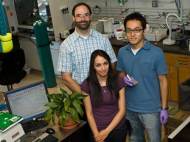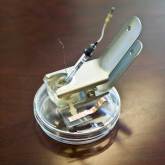MIT researchers develop self-repairing photovoltaic technology
 One of the problems with harvesting sunlight is that sunlight leads to a gradual degradation of many systems developed to harness it. But plants have adopted an interesting strategy to address this issue by constantly breaking down their light-capturing molecules and reassembling them from scratch, thus renewing the basic structures that capture the sun’s energy (for example, a leaf on a tree is recycling its proteins about every 45 minutes).
One of the problems with harvesting sunlight is that sunlight leads to a gradual degradation of many systems developed to harness it. But plants have adopted an interesting strategy to address this issue by constantly breaking down their light-capturing molecules and reassembling them from scratch, thus renewing the basic structures that capture the sun’s energy (for example, a leaf on a tree is recycling its proteins about every 45 minutes).
That process has inspired Michael Strano, the Charles and Hilda Roddey Associate Professor of Chemical Engineering, and his team of graduate students and researchers to create a novel set of self-assembling molecules that can turn sunlight into electricity. The molecules can be repeatedly broken down and then reassembled quickly, just by adding or removing an additional solution.
MIT”s Strano Research Group produced synthetic molecules called phospholipids that form disks which provide structural support for other molecules that actually respond to light, in structures called reaction centers which release electrons when struck by particles of light. The disks, carrying the reaction centers, are in a solution where they attach themselves spontaneously to carbon nanotubes. The nanotubes hold the phospholipid disks in a uniform alignment so that the reaction centers can all be exposed to sunlight at once, and they also act as wires to collect and channel the flow of electrons knocked loose by the reactive molecules.
The system Strano’s team produced is made up of seven different compounds, including the carbon nanotubes, the phospholipids, and the proteins that make up the reaction centers, which under the right conditions spontaneously assemble themselves into a light-harvesting structure that produces an electric current.
“We’re basically imitating tricks that nature has discovered over millions of years” — in particular, “reversibility, the ability to break apart and reassemble”, said Strano. The team, which included postdoctoral researcher Moon-Ho Ham and graduate student Ardemis Boghossian, came up with the system based on a theoretical analysis, but then decided to build a prototype cell to test it out. They ran the cell through repeated cycles of assembly and disassembly over a 14-hour period, with no loss of efficiency.
For conventional silicon-based photovoltaic cells, there is little degradation in performance through time, but many new systems (which are developed for lower cost, higher efficiency, flexibility or other improved characteristics) can have a significant degradation in performance. The individual reactions of these new molecular structures in converting sunlight are about 40 percent efficient. Theoretically, the efficiency of the structures could be close to 100 percent. But in the initial work, the concentration of the structures in the solution was low, so the overall efficiency of the device (the amount of electricity produced for a given surface area) was very low. They are working now to find ways to greatly increase the concentration.
You can find more information in their paper published in Nature Chemistry: “Photoelectrochemical complexes for solar energy conversion that chemically and autonomously regenerate”.










Excellent. Congratulations.
Dr.A.Jagadeesh Nellore(AP),India